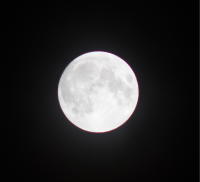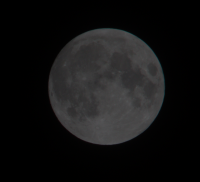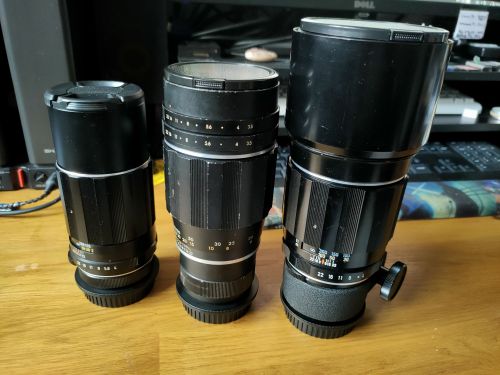Table of Contents
Night Sky Images - 18/11/2021
I wanted to do a comparison between three of my recently acquired Asahi/Pentax Takumar lenses, this was a full moon, so perfect for some detailed images… also the contrast of the bright moon would definitely show up any image problems inherent with the lenses.
Gear:
- Canon EOS 200D
- Asahi Takumar 200mm/F4, 200mm/F3.5, 300mm/F4
- Tripod
Weather:
- Light to medium cloud (10-30%)
Location:
- Garden
Software
- Rawtherapee - RAW file importing, optical correction & image processing
- ASTAP - Image stacking / general astrophotography toolset
- GIMP - RAW/TIF to JPEG, cropping
From left to right; Super Takumar 200mm/F4, Takumar 200mm/F3.5, and then finally the Super Multi Coated Takumar 300mm/F4:
Images
Shutter speeds were kept at 1/125 and ISO at 100 for all images. I found that all three lenses were able to focus to infinity (actually, all three, to varying degrees, would go beyond infinity) with the fitted M42 to EOS adapters, so no problems there.
All of the images below are 100% size crops of the centre section of the original RAW images without any post processing applied. No optical errors have been corrected, no white balance, gamma or noise reduction operations have been run - these are straight out of the camera, what you see is what you get.
Round 1 - F5.6
All lenses are much too bright fully open at their widest settings (F3.5 and F4, respectively), so the first images were with all three lenses stopped down to F5.6
All three lenses show pretty bad chroma around the high contrast edges of the moon at F5.6. The oldest lens, the non-Super 200mm F3.5, probably has the least of all three lenses and is also definitely the sharpest performing at this aperture.
 Fig. 1: 200mm/F4 @ F5.6
Fig. 1: 200mm/F4 @ F5.6
 Fig. 2: 200mm/F3.5 @ F5.6
Fig. 2: 200mm/F3.5 @ F5.6
 Fig. 3: 300mm/F4 @ F5.6
Fig. 3: 300mm/F4 @ F5.6
Round 2 - F8
On all three lenses, F8 is the next marked stop from F5.6, but is actually two clicks away. I didn't try the mid stop and went straight to F8.
Stopping down to F8 reduces the chroma effect on all three lenses; the 200mm F3.5 again shows the best performance and has a substantial reduction in chroma, to the point where it is almost gone. The Super 200mm F4 is also under a lot more control. The S-M-C 300mm F4 is also reduced, but still comparatively bad compared to the other two.
 Fig. 4: 200mm/F4 @ F8
Fig. 4: 200mm/F4 @ F8
 Fig. 5: 200mm/F3.5 @ F8
Fig. 5: 200mm/F3.5 @ F8
 Fig. 6: 300mm/F4 @ F8
Fig. 6: 300mm/F4 @ F8
Round 3 - F11
On all three lenses, F11 is the next marked stop from F8, but is actually two clicks away. I didn't try the mid stop and went straight to F11.
At F11, both the Super 200mm F4 and the 200mm F3.5 show almost no visible chroma. For all intents and purposes, it is gone. The S-M-C 300mm F4 still shows visible chroma at F11 but chroma aside, it is starting to come into its own in terms of resolution of details on the lunar surface.
Something odd happens with the 200mm F3.5 at this point though, as it starts to get much darker compared to its 200mm and 300mm siblings - it's as if the light entering the lens falls off at a much steeper curve moving to F11 compared to the other two Takumar models - and then remains fairly constant in terms of brightness until F22 (as the subsequent results below indicate). ISO and shutter speed remain constant. I'm not aware that I was taking images with this lens with any substantial cloud cover or similar that would explain the darker images. This definitely needs a follow up session to confirm what I am seeing.
 Fig. 7: 200mm/F4 @ F11
Fig. 7: 200mm/F4 @ F11
 Fig. 8: 200mm/F3.5 @ F11
Fig. 8: 200mm/F3.5 @ F11
 Fig. 9: 300mm/F4 @ F11
Fig. 9: 300mm/F4 @ F11
Round 4 - F16
On the 200mm/F4 and 300mm/F4, they both still have two clicks between F11 and F16. On the 200mm/F3.5, it reduces to just a single stop (no half-stop between apertures at this setting).
The Super 200mm F4 starts to fall off in brightness at F16, but still remains usable without any post processing. No visible chroma at this aperture either. The S-M-C 300mm F4 still remains reasonably bright and chroma is slightly reduced again; red fringes are gone, though the blue/green fringe remains clearly visible without zooming in.
The 200mm F3.5 remains at a brightness level virtually identical to its F11 performance.
 Fig. 10: 200mm/F4 @ F16
Fig. 10: 200mm/F4 @ F16
 Fig. 11: 200mm/F3.5 @ F16
Fig. 11: 200mm/F3.5 @ F16
 Fig. 12: 300mm/F4 @ F16
Fig. 12: 300mm/F4 @ F16
Round 5 - F22
On all three lenses, F22 is one stop away from F16.
The Super 200mm F4 is still bright enough to make out details without being too dark at F22. The 200mm F3.5 retains the same nominal brightness level that it did from F11 (which is odd). The big S-M-C 300mm F4 finally has a big fall-off in terms of brightness, reducing to a level roughly equal to the Super 200mm F4 between F11 and F16.
The S-M-C 300mm F4 still has slightly visible chroma, even at F22.
 Fig. 13: 200mm/F4 @ F22
Fig. 13: 200mm/F4 @ F22
 Fig. 14: 200mm/F3.5 @ F22
Fig. 14: 200mm/F3.5 @ F22
 Fig. 15: 300mm/F4 @ F22
Fig. 15: 300mm/F4 @ F22
Summary
I'm really pleasantly surprised by the images from the 'weakest' lens, the Super Takumar 200/F4. Although it has the coated optics (not multi-coated like the 300/F4), it has a much smaller area of glass than the other two lenses, but seems to be a really strong performer.
The Takumar 200/F3.5 is clearly the sharper lens of the two 200mm focal lengths and has a much larger area of glass to collect light. It's a higher quality lens with more features and heavier construction than the 200/F4 and also seems to control chroma (slightly) better. However, I really don't understand what was going on with the sudden (and sustained) brightness fall-off at F11 and above. This needs looking at. If I can work out what is causing the brightness drop-off, I have no doubt that the performance of the 200/F3.5 would remain very good at F11 and F16 and suspect somewhere in the region of F8 - F11 would be the sweet spot of brightness and sharpness.
The Super Multi Coated 300/F4 is a chromatic aberration monster. Visible chroma is present at almost every aperture setting, though it reduces to a very trivial amount by F11 and F16. It, of course, resolves far more detail than the 200mm focal length lenses do, as well as retaining higher brightness levels as it is increasingly stepped down.
Processed Images
Super Takumar 200mm / F4
All chroma removed in Rawtherapee and white, highlight and shadow balance all adjusted a little. No trace of chroma left, and a nice looking image for an old 200mm lens. Really pleased with this one; I wasn't expecting much and am happy with the outcome.
 Fig. 16: Super Takumar 200mm/F4 @ ISO100, 1/100, F8
Fig. 16: Super Takumar 200mm/F4 @ ISO100, 1/100, F8  Fig. 17: Super Takumar 200mm/F4 @ ISO100, 1/100, F8. Cropped
Fig. 17: Super Takumar 200mm/F4 @ ISO100, 1/100, F8. Cropped
 Fig. 18: Super Takumar 200mm/F4 @ ISO100, 1/100, F11
Fig. 18: Super Takumar 200mm/F4 @ ISO100, 1/100, F11  Fig. 16: Super Takumar 200mm/F4 @ ISO100, 1/100, F11. Cropped
Fig. 16: Super Takumar 200mm/F4 @ ISO100, 1/100, F11. Cropped
Takumar 200mm / F3.5
Definitely a more serious lens than the 200/F4. Again, all of the chroma / fringing was easy to clean up in Rawtherapee. I'm sure this is capable of better performance at F11 and higher, but whether it was the conditions, or me being new to this lens, it just didn't work out this time.
 Fig. 16: Super Takumar 200mm/F3.5 @ ISO100, 1/100, F8
Fig. 16: Super Takumar 200mm/F3.5 @ ISO100, 1/100, F8  Fig. 16: Super Takumar 200mm/F3.5 @ ISO100, 1/100, F8. Cropped
Fig. 16: Super Takumar 200mm/F3.5 @ ISO100, 1/100, F8. Cropped
 Fig. 18: Super Takumar 200mm/F3.5 @ ISO100, 1/100, F11
Fig. 18: Super Takumar 200mm/F3.5 @ ISO100, 1/100, F11  Fig. 18: Super Takumar 200mm/F3.5 @ ISO100, 1/100, F11. Cropped
Fig. 18: Super Takumar 200mm/F3.5 @ ISO100, 1/100, F11. Cropped
Super Multi Coated Takumar 300mm / F4
Although the Asahi Super-Multi-Coated Takumar 300/F4 has really pronounced chroma at virtually every aperture settings, almost all of it can be got rid of or minimised to an extent where it is not immediately noticeable.
The images below, two full frame and two cropped sections at F11 and F16, show that will just careful white balance and highlights and the application of some chromatic aberration removal steps in Rawtherapee (chroma removal tool and the de-fringing tool in the red/blue regions), it can produce some really clean images:
 Fig. 16: S-M-C Takumar 300mm/F4 @ ISO100, 1/100, F11
Fig. 16: S-M-C Takumar 300mm/F4 @ ISO100, 1/100, F11  Fig. 16: S-M-C Takumar 300mm/F4 @ ISO100, 1/100, F11. Cropped
Fig. 16: S-M-C Takumar 300mm/F4 @ ISO100, 1/100, F11. Cropped
 Fig. 16: S-M-C Takumar 300mm/F4 @ ISO100, 1/100, F16
Fig. 16: S-M-C Takumar 300mm/F4 @ ISO100, 1/100, F16
 Fig. 16: S-M-C Takumar 300mm/F4 @ ISO100, 1/100, F16. Cropped
Fig. 16: S-M-C Takumar 300mm/F4 @ ISO100, 1/100, F16. Cropped

